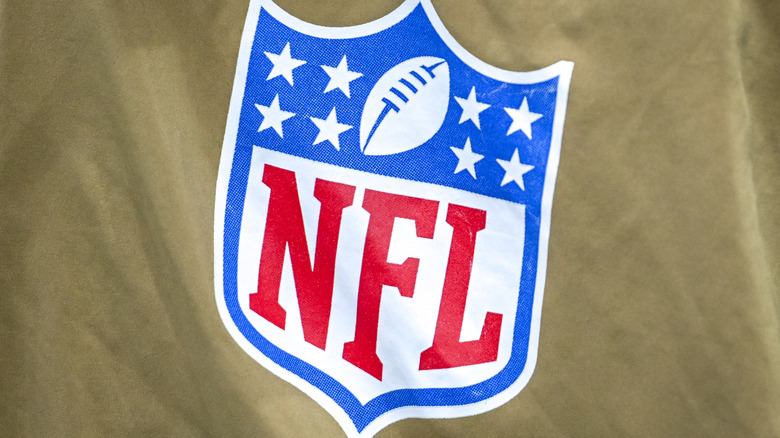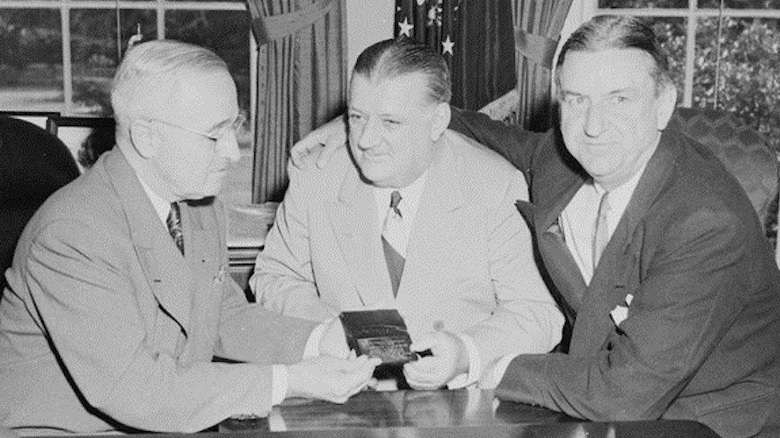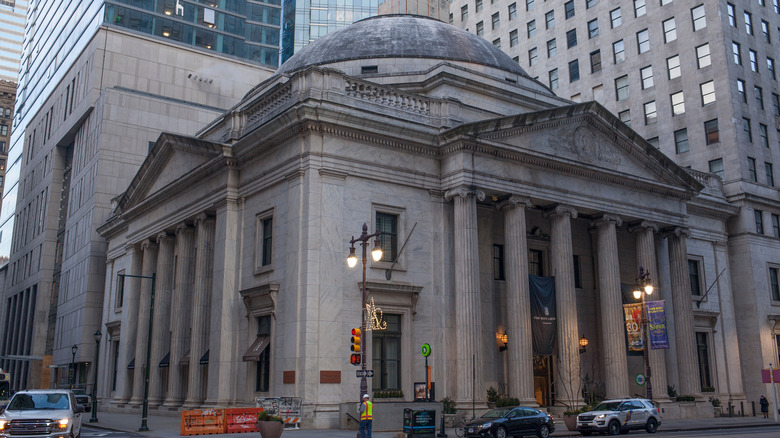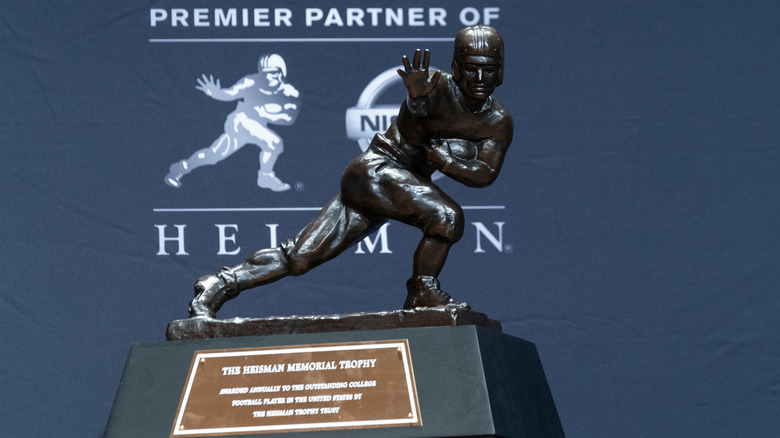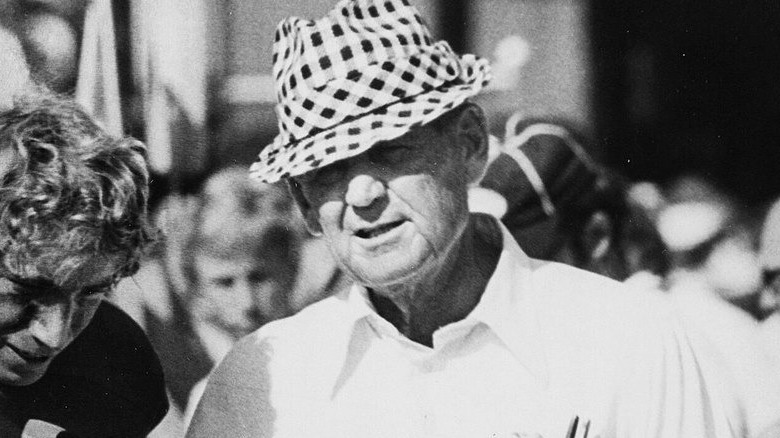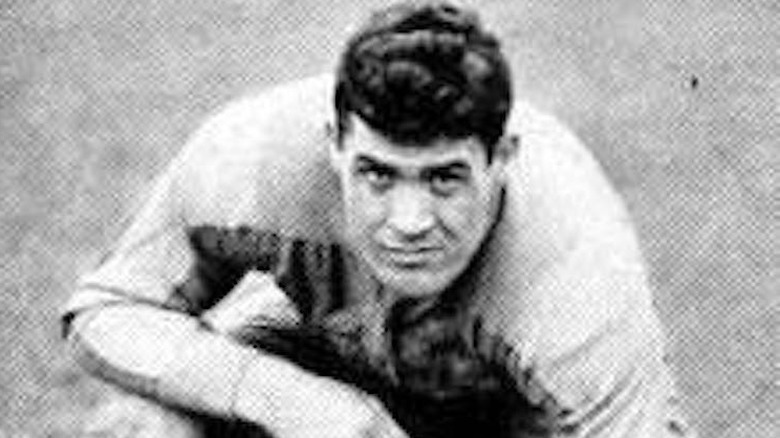What Was The Very First NFL Draft Like?
The 2022 NFL Draft is fast approaching at the time of writing, and speculation is rife as to who the Jacksonville Jaguars will be picking with their second consecutive No. 1 overall pick. Last year's top pick, Trevor Lawrence, had a rough rookie campaign amid all the drama in Jacksonville, but with the Urban Meyer debacle now past us, will things be any different for whoever goes to the Jaguars at No. 1 on April 28? It's questions such as this that make the modern NFL draft so intriguing, but 86 years ago, when the league first held the event, it just wasn't a very hot conversation topic for the average sports fan.
The 1936 NFL Draft, for certain, was far from the spectacle that we currently know and love. There were no green rooms, no commissioner announcing the draft picks onstage, no fans, no players attending live with their parents, girlfriends, and other loved ones, and there was no live entertainment either. (The Machine Gun Kelly of those days was a gangster locked up at Alcatraz, not a rapper-slash-rocker performing before his hometown crowd at the end of the draft.) But beyond that basic idea of a simpler, more austere draft than the modern-day version we follow so closely every April, what went down in the 1936 NFL Draft, and how was it different from — or similar to — today's NFL drafts?
The birth of the NFL draft
The idea behind professional sports drafts is that less talented teams need a fair chance to catch up with the rest of the competition by acquiring the best amateur players. Without a draft, it wouldn't have been inconceivable for, say, LeBron James to sign with the Kobe Bryant and Shaquille O'Neal-led Los Angeles Lakers straight out of high school in 2003, or for Joe Burrow to instantly step into Tom Brady's shoes and join the New England Patriots as a rookie quarterback in 2020. We all know what really happened — the Cleveland Cavaliers drafted James, and he only signed with the Lakers as a free agent in 2018, and Burrow, who was picked first overall by the Cincinnati Bengals, led his team to the Super Bowl earlier this year in just his second season.
Going way back to 1935, Philadelphia Eagles owner Bert Bell (pictured above at center, with President Harry Truman and Washington Redskins owner George Preston Marshall) was the one who first cooked up the idea of a rookie draft. And on May 19 of that year, the league's team owners approved that plan. The future NFL commissioner's idea was for the league's weaker squads to have first dibs on college football's finest, with all teams drafting in reverse order based on the previous season standings; the worst team goes first, and the league champions pick last at the end of each round. It was a simple, no-frills solution whose basic concept hasn't been altered too much in the eight-plus decades since then, and it was all in the name of establishing greater parity.
A low-profile event with no Bells (except Bert) and whistles
On February 8, 1936, the NFL held its first-ever rookie draft at the Ritz-Carlton Hotel in Philadelphia — not a surprising choice of location since the man who conceived it, Bert Bell, owned the Eagles, and coincidentally, the draft's No. 1 pick as well. According to The Washington Post, there was no fanfare whatsoever surrounding the event, which meant no coverage on the radio, and not even in leading newspapers. Back then, the "N" in NFL might as well have stood for "novelty," as that's what many people thought of pro football — not as popular or as interesting as its college equivalent, and definitely nowhere near as appealing as other sports like baseball, boxing, or even horse racing.
Given its lack of mainstream appeal, 1930s-era pro football didn't have any equivalent to the likes of Mel Kiper Jr. providing scouting reports or projections for prospective rookies — there was no such thing as sports analysts talking about how this Tuffy Leemans kid from George Washington (more on him later) might turn out to be the next Red Grange or Bronko Nagurski. It also seemed as if team owners knew little about player stats either. And just as we noted above, it was only the owners present for the 1936 NFL Draft, with nobody else in attendance.
The top pick won the Heisman but never played professional football
It's been virtually automatic for the past several decades — if you won the Heisman Trophy in college and went on to become the No. 1 pick in the NFL Draft, that would mark the beginning of what should ideally be a long and successful professional football career. After all, the money is good in the NFL, even if you're one of those guys who spends most of his time on special teams, so why turn down an offer to become an instant millionaire if you're a Heisman winner and top draft pick?
Of course, it wasn't always like that in pro sports, and that's why Jay Berwanger, the 1935 Downtown Athletic Club (later Heisman) Trophy winner and first overall pick in the NFL's first-ever draft in 1936, said no to the pros. The former University of Chicago Maroons star halfback was selected by the Philadelphia Eagles, but the Chicago Bears traded for his rights and hoped to sign the hometown hero to the squad. But since Bears founder/owner/head coach George Halas didn't want to pay Berwanger more than what he was requesting, the ex-college standout opted to work as a salesman instead, and never played a down of professional football.
Berwanger wasn't alone as a top college athlete who never played pro sports despite being drafted first overall. Texas Wesleyan's Clifton McNeely was the first-ever No. 1 pick in NBA Draft history back in 1947, but as The Dallas Morning News pointed out, he wasn't interested in signing with the team that drafted him (the long-since-defunct Pittsburgh Ironmen). He then worked briefly in the oil industry before becoming a high school basketball coach and spending 25 years as a school administrator in his home state of Texas.
The draft featured some interesting names ... and a future coaching legend
A look at the 81 players selected in the 1936 NFL Draft reveals some rather interesting names, though a couple of them are interesting because of the names themselves, as opposed to the players' accomplishments. At No. 3 overall, the Pittsburgh Steelers selected a Notre Dame halfback by the name of William "Bill" Shakespeare, but when "to be or not to be an NFL player" was the question, he, just like Jay Berwanger, chose "not to be." As pro football was still far from being a lucrative means of employment, "The Bard of South Bend" eschewed the NFL for the Cincinnati Rubber Company, where he would later become the company's president (via Yardbarker).
At No. 80 overall, Yale end Bob Train was one pick away from being the first-ever "Mr. Irrelevant" in NFL draft history, but he did, at least, have the most appropriate of nicknames — "Choo Choo."
However, the most fascinating of the inaugural draftees who didn't end up playing in the NFL has to be the player selected at No. 31, Alabama end Paul Bryant (pictured above). He was chosen by the now-defunct Brooklyn Dodgers, and while he didn't crack their lineup or play for any other NFL team afterward, the man they called "Bear" went on to have a Hall of Fame career as a college football head coach, racking up 323 combined wins for Maryland, Kentucky, Texas A&M, and his college alma mater, Alabama.
The 1936 draft produced four Hall of Famers
If scouting is far from being a perfect science in present times, that was all the more true in 1936 when the NFL's "draft board" was simply a list of 90 graduating players for the nine team owners to choose from (via The Washington Post). As such, early professional sports drafts frequently featured players who slipped through the cracks and carved out Hall of Fame careers despite not getting picked early.
Per Pro Football Reference, there were four players in the draft class of 1936 who were eventually inducted into the Pro Football Hall of Fame, starting with the sixth overall selection, West Virginia tackle Joe Stydahar (pictured above). Huge for his time at 6-feet-4-inches and 233 pounds, "Jumbo Joe" was a pretty good consolation prize for the Chicago Bears, who, as noted earlier, failed to come to terms with top pick Jay Berwanger. Stydahar was a four-time All-Pro selection who won three NFL championships with the Bears before retiring in 1946 — or 21 years before he made it to Canton.
Also getting inducted were pick No. 18, George Washington University fullback Tuffy Leemans, who, as a New York Giants rookie in 1936, led the league in rushing with 836 yards, and two of the draft's later selections — Notre Dame end Wayne Millner (No. 65, Boston Redskins) and Colgate guard Danny Fortmann (No. 78, Chicago Bears).
